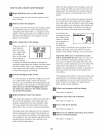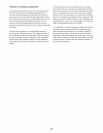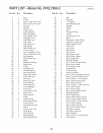
CONDITIONING GUIDELINES
AWARNING'.
Before beginning this or any exercise pro-
gram. consult your physician.Thisisespe-
cially important for persons over the age of 35
or persons with pre-existing health problems.
The putse sensor is not a medicaJ device.
Various factors may affect the accuracy of
heart rate readings, The pulse sensor is
intended only as an exercise aid in determin_
ing heart rate trends in general,
The following guidelines will help you to plan your
exercise program, Remember that proper nutrition
and adequate rest are essential for successful results,
Each workout should include the following three parts:
Warming Up--Begin each workout with 5 to 10 rain=
utes of stretching and light exercise, A proper warm-
up increases your body temperature, heart rate, and
circulation in preparation for exercise.
Training Zone Exercise--Each workout should con-
sist of 20 to 30 minutes of exercising with your heart
rate in your training zone. Note: During the first few
weeks of your exercise program, do not keep your
heart rate in your training zone for longer than 20 min-
utes.
Cooling Down--End each workout with 5 to 10 min=
utes of stretching. This will increase the flexibility of
your muscles and will help to prevent post=exercise
problems.
To maintain or improve your condition, plan three
workouts each week, with at least one day of rest
between workouts. Schedule your workouts for the
time of day when your energy level is the highest.
After a few months of regular exercise, you may com=
plete up to five workouts each week, if desired.
Remember, the key to success is make exercise a
regular and enjoyable part of your everyday life.
CARDIOVASCULAR TRAINING GUIDEUNES
Whether your goal is to burn fat or to strengthen your
cardiovascular system, the key to achieving the
desired results is to exercise with the proper intensity.
The proper intensity level can be found by using your
heart rate as a guide.
The chart below shows recommended heart rates for
fat burning, maximum fat burning, and cardiovascular
(aerobic) exercise.
Z65 155 145 140 130 125 115 _
145 138 130 125 118 110 !03 _)
125 120 115 II0 105 95 90
20 30 40 50 60 70 80
To find the proper heart rate for you, first find your age
at the bottom of the chart (ages are rounded off to the
nearest ten years). Next, find the three numbers
above your age. The three numbers are your "training
zone." The lowest number is the recommended heart
rate for fat burning, the middle number is the recom-
mended heart rate for maximum fat burning, and the
highest number is the recommended heart rate for
aerobic exercise.
Fat Burning--To burn fat effectively, you must exer-
cise at a relatively low intensity level for a sustained
period of time. During the first few minutes of exer-
cise, your body uses easily accessible carbohydrate
calories for energy. Only after the first few minutes of
exercise does your body begin to use stored fat calo-
ries for energy. If your goal is to burn fat, adjust the
intensity of your exercise until your heart rate is near
the lowest number in your training zone as you exer-
cise. For maximum fat burning, adjust the intensity of
your exercise until your heart rate is near the middle
number in your training zone as you exercise.
Aerobic Exercise--If your goal is to strengthen your
cardiovascular system, your exercise must be "aero-
bic." Aerobic exercise is activity that requires large
amounts of oxygen for prolonged periods of time. This
increases the demand on the heart to pump blood to
the muscles, and on the lungs to oxygenate the
blood. For aerobic exercise, adjust the intensity of
your exercise until your heart rate is near the highest
number in your training zone.
22


















